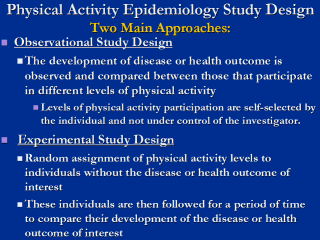| front |1 |2 |3 |4 |5 |6 |7 |8 |9 |10 |11 |12 |13 |14 |15 |16 |17 |18 |19 |20 |21 |22 |23 |24 |25 |26 |27 |28 |29 |30 |31 |32 |33 |34 |review |
 |
There are two main
approaches that investigators can use to determine if physical inactivity
plays a role in the development of a specific disease or condition. In the observational study design, levels of physical activity participation are self-selected by the participant. Typically, individuals will differ by characteristics (confounders), other than physical activity participation, that may influence the disease or outcome of interest. Of the two main approaches, the experimental study design is more powerful and conclusive than the observational study design. It is more conclusive because the levels of physical activity are not self-selected by the participant. Individuals are randomly assigned to a group that is encouraged to participate in physical activity or to a reference group. All study participants are followed for a period of time and development of disease or health outcome is compared between groups. Random assignment or randomization implies that each individual has the same chance of being in any of the available study groups. The randomization process removes any potential clinician and/or patient biases about who receives the physical activity intervention. Also, randomization ensures equal distribution of potential confounding variables (age, body mass index, etc.) among exposure groups. The equal distribution of confounding variables will lead to a clearer picture of the association between physical activity and the disease or health outcome of interest. Recommended Readings: Kriska AM, FitzGerald SJ, Pereira MA (2001). Physical activity epidemiology. In: S Brown, Introduction to exercise science. Philadelphia, PA: Lippincott Williams & Wilkins: 193-211. Friis RH, Sellers TA (1996). Epidemiology for Public Health Practice. Gaithersberg, MD: Aspen Publishers: 271. |